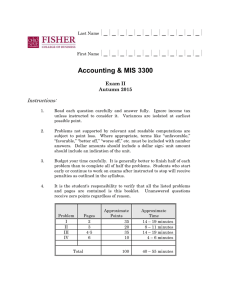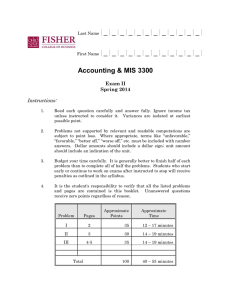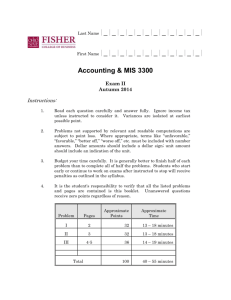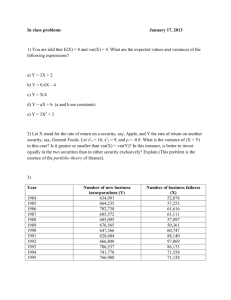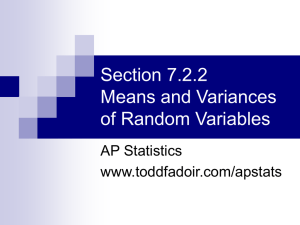Accounting & MIS 3300
advertisement
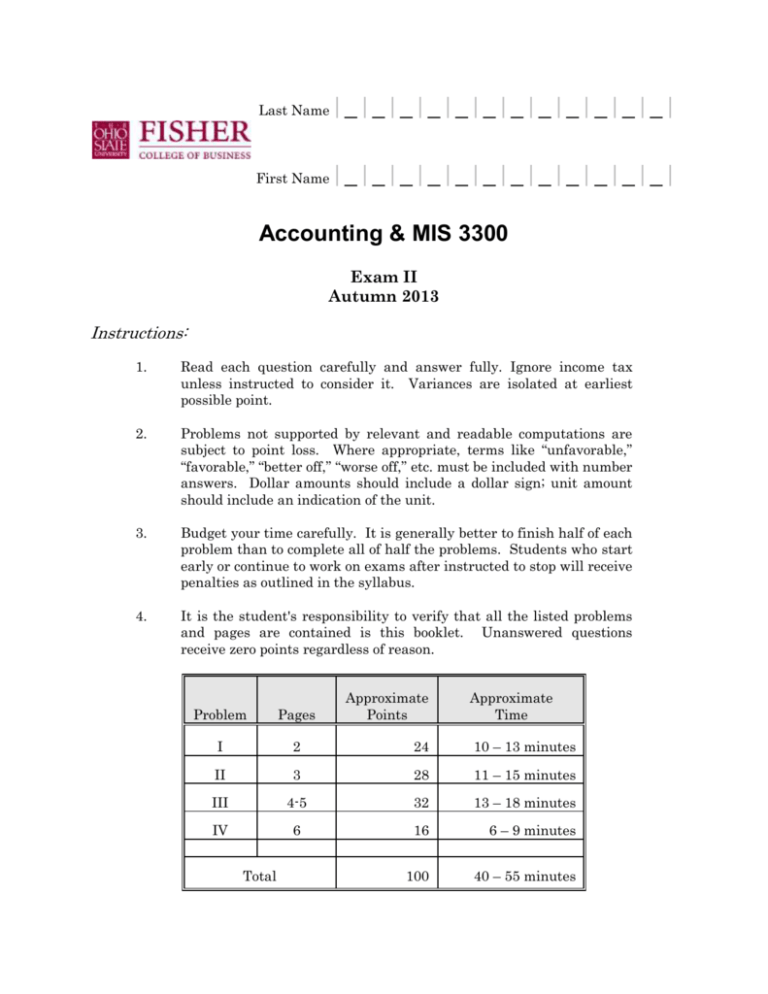
Last Name |_|_|_|_|_|_|_|_|_|_|_|_| First Name |_|_|_|_|_|_|_|_|_|_|_|_| Accounting & MIS 3300 Exam II Autumn 2013 Instructions: 1. Read each question carefully and answer fully. Ignore income tax unless instructed to consider it. Variances are isolated at earliest possible point. 2. Problems not supported by relevant and readable computations are subject to point loss. Where appropriate, terms like “unfavorable,” “favorable,” “better off,” “worse off,” etc. must be included with number answers. Dollar amounts should include a dollar sign; unit amount should include an indication of the unit. 3. Budget your time carefully. It is generally better to finish half of each problem than to complete all of half the problems. Students who start early or continue to work on exams after instructed to stop will receive penalties as outlined in the syllabus. 4. It is the student's responsibility to verify that all the listed problems and pages are contained is this booklet. Unanswered questions receive zero points regardless of reason. Approximate Points Approximate Time Problem Pages I 2 24 10 – 13 minutes II 3 28 11 – 15 minutes III 4-5 32 13 – 18 minutes IV 6 16 6 – 9 minutes 100 40 – 55 minutes Total Page 2 of 6 PROBLEM I Asare Company has the following per-unit standards for 20x1: Direct Materials Direct Labor Variable Manu. Overhead 5 lbs. @ $10.60 per lb. 3 direct-labor hours @ $16.00 per direct-labor hour 2 machine hours @ $22.00 per machine hour Budgeted fixed manufacturing overhead was $680,000. Asare used a denominator level of 50,000 machine hours. Actual production was 24,000 units using 47,000 machine hours, and the following occurred: Direct Materials: Direct Labor: Manu. Overhead: Purchased 148,000 lbs. for $1,613,200 and used 116,000 lbs. Paid $1,197,000 for 76,000 direct-labor hours Incurred $1,000,000 (variable) and $720,000 (fixed) Required: Compute the variances requested and place in boxes below. Direct Material Price Variance Direct Labor Price Variance Variable Manu. Overhead Spending Variance Fixed Manu. Overhead Spending Variance Direct Material Efficiency Variance Direct Labor Efficiency Variance Variable Manu. Overhead Efficiency Variance Fixed Manu. Production-Volume Variance Page 3 of 6 PROBLEM II The Chang Company has the following standards: Direct Materials Direct Labor Manufacturing Overhead 3 lbs. @ $6.50 per lb. 6 hours @ $24.00 per hr. $37.00 per direct-labor hour and the following results: Revenues Cost of direct materials purchased Direct Material Price Variance Direct Material Efficiency Variance Direct Labor Price Variance Direct Labor Flexible-Budget Variance $3,740,000 622,300 14,700 F 39,000 U 78,750 U 185,250 F Chang used a denominator level of units of 30,000, actually manufactured 31,000 units, and sold 26,000. Calculate the items requested below: Standard direct labor hours allowed for actual output Actual direct labor hours worked Actual average direct labor wage rate Standard pounds of direct materials allowed Actual pounds of direct materials used Actual pounds of direct materials purchased Actual average direct materials price per pound Page 4 of 6 PROBLEM III The Bright Company began operations in January of 20x1 and decided to use FIFO. The following is known: January 20x1 February 20x1 Production 900 units 700 units Sales ($190 per unit) 600 units 800 units Budgeted Variable Manufacturing $75 per unit $75 per unit Budgeted Fixed Manufacturing $50,400 per month $50,400 per month Variable Operating Costs $12 per unit sold $12 per unit sold Fixed Operating Costs $15,000 per month $15,000 per month Part A. Bright uses a normal absorption costing system and a denominator level of 800 each month. Bright had no price, spending, or efficiency variances. Production-volume variances, if any, are closed to cost of goods sold. Required: produce the January and February income statements in good form. Page 5 of 6 PROBLEM III CONTINUED Part B. Assume Bright uses actual variable costing. Required: calculate the net income for each of the two months. January: $ February: $ Part C. Required: present below a succinct, properly labeled, and professional schedule that starts with the actual variable net income numbers in part B and arrives at the net income numbers under actual absorption costing for the each of the two months. Page 6 of 6 PROBLEM IV The Ramirez Company has been selling at two weekend events, having these results: Sales Revenue Expenses Profit Event 1 17,000 units $ 391,000 367,000 $ 24,000 Sales Revenue Expenses Profit Event 2 29,000 units $ 667,000 559,000 $ 108,000 They have the opportunity to sell at a future event that is expected to have the same revenue and cost structure as the above events, plus an “event fee” not previously required. The promoters of the event require Ramirez to choose, well before the event, an event fee to attend that either a) requires a $30,000 payment or b) requires them to pay 4% of sales. Ramirez cannot back out after choosing fee type. Ramirez estimates sales will be 45,000 units if the weather is “clear” and 25,000 units if the weather is “foul.” The weather has a 60% chance of being clear when the event occurs. Required: Calculate the value to Ramirez of a perfectly accurate prediction of the weather prior to signing the contract with the promoters. Show your answer in good form!
